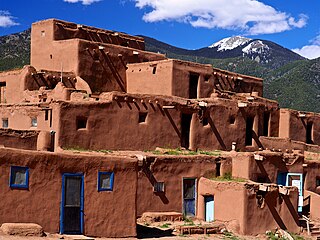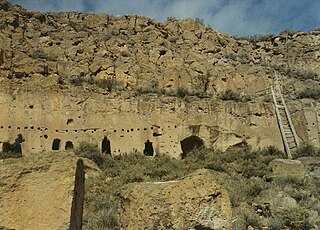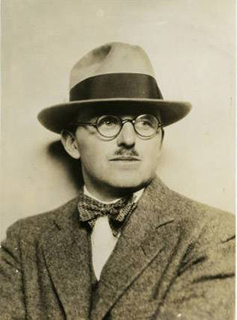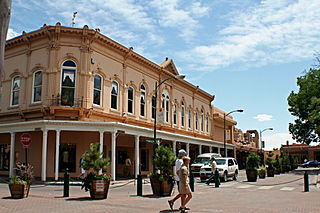The Puebloans, or Pueblo peoples, are Native Americans in the Southwestern United States who share common agricultural, material, and religious practices. Among the currently inhabited Pueblos, Taos, San Ildefonso, Acoma, Zuni, and Hopi are some of the best-known. Pueblo people speak languages from four different language families, and each Pueblo is further divided culturally by kinship systems and agricultural practices, although all cultivate varieties of maize.

Taos Pueblo is an ancient pueblo belonging to a Taos-speaking (Tiwa) Native American tribe of Puebloan people. It lies about 1 mile (1.6 km) north of the modern city of Taos, New Mexico. The pueblos are considered to be one of the oldest continuously inhabited communities in the United States. This has been designated a UNESCO World Heritage Site.

Bandelier National Monument is a 33,677-acre (13,629 ha) United States National Monument near Los Alamos in Sandoval and Los Alamos counties, New Mexico. The monument preserves the homes and territory of the Ancestral Puebloans of a later era in the Southwest. Most of the pueblo structures date to two eras, dating between 1150 and 1600 AD.

The Puye Cliff Dwellings are the ruins of an abandoned pueblo, located in Santa Clara Canyon on Santa Clara Pueblo land near Española, New Mexico. The site was declared a National Historic Landmark in 1966.

The Palace of the Governors is an adobe structure built in the Territorial Style of Pueblo architecture on Palace Avenue in Santa Fe, New Mexico. Located within the Santa Fe Historic District along the Santa Fe Plaza between Lincoln and Washington avenues, it has served as the seat of government for New Mexico for centuries, having been established as the capitol building of Nuevo México in 1610.

San Miguel Chapel, is a Spanish colonial mission church in Santa Fe, New Mexico. Originally built around 1610, it is often referred to as the oldest church in the United States. The church was rebuilt twice, once in the mid to late 17th century, and again in 1710 following the Pueblo Revolt. In both cases earlier pieces of the building may have been reused, though it is unclear to what extent. The wooden reredos, which includes a wooden statue of Saint Michael dating back to at least 1709, was added in 1798.

St. Michael's High School is a private Catholic junior/senior high school located in Santa Fe, New Mexico. It is privately run under the auspices of the international Institute of the Brothers of the Christian Schools, better known as the De La Salle Christian Brothers.

John Gaw Meem IV was an American architect based in Santa Fe, New Mexico. He is best known for his instrumental role in the development and popularization of the Pueblo Revival Style and as a proponent of architectural Regionalism in the face of international modernism. Meem is regarded as one of the most important and influential architects to have worked in New Mexico.

The Pueblo Revival style or Santa Fe style is a regional architectural style of the Southwestern United States, which draws its inspiration from Santa Fe de Nuevo México's traditional Pueblo architecture, the Spanish missions, and Territorial Style. The style developed at the beginning of the 20th century and reached its greatest popularity in the 1920s and 1930s, though it is still commonly used for new buildings. Pueblo style architecture is most prevalent in the state of New Mexico, it is often blended with the Territorial Revival architecture.

The Santa Fe Plaza is a National Historic Landmark in downtown Santa Fe, New Mexico in the style of traditional Spanish-American colonial cities. The plaza, or city square is a gathering place for locals and also a tourist attraction. It is home to annual events including Fiestas de Santa Fe, the Spanish Market, the Santa Fe Bandstand, and the Santa Fe Indian Market.

The Barrio de Analco Historic District is a National Historic Landmark District centered at the junction of East De Vargas Street and Old Santa Fe Trail in Santa Fe, New Mexico. The seven buildings of the district represent one of the oldest clusters of what were basically working-class or lower-class residences in North America, and are in a cross-section of pre-statehood architectural styles. It includes two of the oldest colonial-era buildings in the southwest, the San Miguel Mission church (1710), and the "Oldest House", built in 1620 and now a museum. The district was declared a National Historic Landmark in 1968.

San Estévan del Rey Mission Church is a Spanish mission church on the Acoma Pueblo Reservation in western New Mexico. Built between 1629 and 1641, it is one of the finest extant examples of hybrid Spanish Colonial and Puebloan architectural styles. It was named for Saint Stephen I of Hungary. The church was declared a National Historic Landmark in 1970, and is listed on the National Register of Historic Places.

Santa Fe is the capital of the U.S. state of New Mexico. The name "Santa Fe" means 'Holy Faith' in Spanish, and the city's full name as founded remains La Villa Real de la Santa Fe de San Francisco de Asís.

Vigas are wooden beams used in the traditional adobe architecture of the American Southwest, especially New Mexico. In this type of construction, the vigas are the main structural members carrying the weight of the roof to the load-bearing exterior walls. The exposed beam ends projecting from the outside of the wall are a defining characteristic of Pueblo architecture and Spanish Colonial architecture in New Mexico and often replicated in modern Pueblo Revival architecture. Usually the vigas are simply peeled logs with a minimum of woodworking. In traditional buildings, the vigas support latillas (laths) which are placed crosswise and upon which the adobe roof is laid, often with intermediate layers of brush or soil. The latillas may be hewn boards, or in more rustic buildings, simply peeled branches. These building techniques date back to the Ancestral Puebloan peoples, and vigas are visible in many of their surviving buildings.

Hundreds of Ancestral Puebloan dwellings are found across the American Southwest. With almost all constructed well before 1492 CE, these Puebloan towns and villages are located throughout the geography of the Southwest.

Pueblo architecture refers to the traditional architecture of the Pueblo people in what is now the Southwestern United States, especially New Mexico. Many of the same building techniques were later adapted by the Hispanos of New Mexico into the Territorial Style. Pueblo and Hispano architecture was also the basis for the Pueblo Revival architecture and Territorial Revival architecture, 20th-century Southwestern regional styles that remain popular.

Scholes Hall is the historic administration building of the University of New Mexico, located on the main campus in Albuquerque. It was the first of many buildings designed for the university by Santa Fe architect John Gaw Meem, who helped to cement the Pueblo Revival style as the "official" architecture of the campus. Built in 1934–36 with Public Works Administration funding, it is regarded as one of Meem's most notable designs.

The Lamy Building, also known as St. Michael's Dormitory, is a historic building in Santa Fe, New Mexico. It was built in 1878 as the main building of St. Michael's College, the predecessor of St. Michael's High School and the College of Santa Fe. The building is a contributing property in the Barrio De Analco Historic District and currently serves as the headquarters of the New Mexico Tourism Department.

Astialakwa was a prehistoric and historic village built by the ancestral Puebloan people located within the Astialakwa Archeological District, in an area now known as the Jemez Springs area of Northern New Mexico. The archeological area is on the National Register of Historic Places.

The Gutiérrez Hubbell House also known as the James Lawrence and Juliana Gutierrez y Chavez Hubbell House, is a historic territorial-style hacienda. The original house dates back to the 1820s, and was enlarged in the 1850s and 1860s. It is located in the village of Pajarito in the South Valley of Albuquerque, New Mexico. The house has existed under three national flags: Spain, Mexico and the United States.























